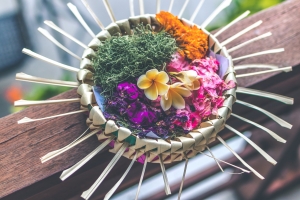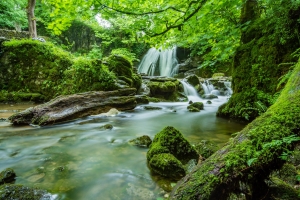At times it feels like we are all in our little boats steering uncharted waters, praying we don’t spring a leak or get flattened by a gigantic wave. Such is life in the time of corona. One thing I’m hearing a lot is that people are looking at what they truly need in life and what is meant by “wealth” and they are beginning to realise that it’s health not prosperity that is precious and the true wealth.
Seeing the sky so clear without pollution, being able to hear the birdsong, watching as Nature is allowed to thrive – brings it home that a healthy environment is also the “need” we all truly need to live in good health.
Sharing this excellent article (with permission and gratitude) by the acclaimed Dr Bhaswati Bhattacharya.
The New Frontier of Pre-scientific Laws of Epidemics
In a race against time, as scientific experts search for a cure and vaccine against the novel virus, CoVid-19, Ayurveda physicians, followers and people of traditional India are quietly oiling their nose with sesame oil or ghee, drinking neem and tulsi kwatha, gathering herbs for sunrise and sunset dhoopana, and sipping warm water.
Their westernized, often wealthier neighbours scoff at them for their adherence to superstitions and archaic pre-scientific samskaras. But these rituals from the most ancient systematic science of healing may well rise from the ashes of oppression that rendered them forbidden 200 years ago. In a nefarious scheme to disjoin ancient Indian sciences, Ayurveda’s original texts are secretly held hostage in rare manuscript libraries in Europe of its imperialist assassins. Meanwhile, Ayurveda is vilified and ridiculed while a non-health, non-care healthcare system has crept in as the new imperialist.
Before 1500CE, the center of the world was the coastline of the Ratnakara, known also as the Eastern Ocean and now as the Indian Ocean, with men carrying cargo from Indonesia to Italy. As sea trade and conquests on land brought word of contagious diseases in far away places, ancient Indian sciences enforced janapada-uddhvansa, the laws of epidemics more tightly, using caste, religion, and anything that would place boundaries to prevent inter-mingling.
From the time of the Egyptians, pestilence, plague, and Japanese smallpox had killed millions. The plagues came in waves, with tales of the China Plague just after the time of Buddha, to the Black Death wiping out half of Europe in the 1300s, traveling via increased sea trade. The deaths took most of the intelligentsia who could travel by ship between Greece, Constantinople and the great libraries of Alexandria and Rome that housed stolen books from Indian ships. As the Dark Ages consumed Europe just after Rome fell in 376 CE, the common people of Europe never learned the great wisdom from those ancient Indian texts. They never learned to follow the rules of hygiene known as ucchiṣṭa, and the advanced city planning developed in the Indus Valley to usher away contaminated waters. They renamed the Indian Ocean to the Erythraean Ocean, as Power-hungry men took advantage of lands with weakened people to dominate with fear for one thousand years. They lived in pestilence until the European Renaissance around 1450. During that time, the fabled spices and healing magical potions of exotic herbs made them yearn. One of the first things they did as empires emerged was raise East India companies to find and conquer the mythical land of India. They refound the Americas for 300 years.
Meanwhile, for 5000 years, the people of Bharat continued to live happy lives, with the occasional conquest or invader trying to sweep across the subcontinent. The Greeks, Arabians, Persians, Egyptians all wondered how those people on the other side of the Indus – the Hindus – lived so well. The land was full of natural riches but more importantly, people who knew how to commune with the gifts of nature and create advanced crafts of textiles, ornate doorways and grand functional roofs, sophisticated mathematical architectures in temples, gorgeous medicinal music, and deep clean wells that preserved waters for centuries. These people understood the medicinal use of gemstones and opulent jewellery, made therapeutic clothes, and healing medicines from plants and aromatic spices. Visitors came to learn of the remedies, and began to covet the healing spices: golden turmeric, carminative cumin, cleansing pippali, mucolytic licorice. Waves of invaders came to steal the spices, hunting for the fountain of youth, the ojas-building ghee, golden water, and herbal formulations that cured infections and neurological debilitations.
Ancient Laws of Epidemics
With keen perception of nature, ancient wisemen preserved the health of the public by observing that land, water, air, and time are the factors for mitigating cycles of disease caused by invisible agents. They observed diseases that spread silently by man’s ignorance and learned how to stop them early, providing clear guidelines of preventive medicine, intervention and restoration. After observing and debating the efficacy of cures for a thousand years that kept pandemics from ripping apart the cultures of the subcontinent, the vaidyas wrote the already-ancient knowledge into medical texts. These are still followed today quietly simply because they work.
In times of crisis, the Ayurvedic solution was to clean the land, make the water flow, and burn anti-microbial and poisonous plants into the air, to re-establish harmony in the environment and ecology of trees, birds, animals and soil. The body was also treated as part of the land, giving purification and restoration. During times of peace, the guidelines of dinacharya and rtucarya were the norm across the subcontinent, inculcating fasting and fruits, powders and panchamrit into cultural festivals and deities’ birthdays. Day-to-day practices using rules of juttha जूठा or ettho এেঠা halted spread of disease. These guidelines were then engraved into societal laws using religion and caste to enforce their importance, necessitated by the violation of the average dim-witted men for whom gentle guidelines did not convince.
Many bharatiya rituals today are direct descendants of janapada-uddhvansa, including hygiene rules of ucchiṣṭa, dhoopana at sunrise and sunset known now as fumigation, lighting of diyas thrice daily at each sandhya, bathing before cooking, changing into clean clothes before entering the inner portions of the house, washing the feet and hands before bed, fumigation and oiling before and after sex, separation of utensils for serving and for eating, oiling the nose before traveling, and not wearing shoes indoors.
To the untrained eye, these practices are samskaras, superstitious acts with no scientific basis. To the initiated mind, for whom the nuances of these rituals are second nature because we grew up with ucchiṣṭa, they resemble the best clinical guidelines used in surgical suites, tissue culture labs and microbiology lockdown units.
The War against MisInformation
Armed with the germ theory and the cell theory, soldiers of modern medicine engage cyclically since their birth in 1849, in campaigns against all medical systems that do not propagate pharmaceutical chemistry-based medicine. Noone has reminded them that advanced microscropy of cell biologists embarrassingly reported twenty years ago that the cell theory was an artifact of low-power microscopes. Scientists recently proudly “discovered” the interstitium, which Ayurvedic clinicians have used as highways between skin and muscle to deliver oil-imbedded herbal chemicals and energy for millennia. WHO has been campaigning against antimicrobial resistance created by overzealous germ theorists, acquiescing that host and environment may be more important than the rigid war against germs. Awkwardly, microbiome science has revealed that we are laden with 9x more bacteria and germs on and in our bodies than human cells. Germs have also been found to have more dynamic avatars that change with seasons, defying the few forms that microbiologists use as fixed targets for antibiotics. Ayurveda knew them as bhuta and krimi, invisible invaders that were half-living predators and wrote extensively about prevention as well as treatment, noting that the most advanced manufacturers of antimicrobial nanomedicines were plants and trees that sequestered minerals and metals.
Scientists are perplexed by the challenges of viruses like corona, and all the diseases they cannot cure, but they dare not venture far from pharmaceutical science. Even with hard data that modern medicine is one of the leading causes of death in monied countries, biomedical scientists blindly defend their pills and surgery while shouting Misinformation! at Ayurveda, and demanding evidence served to them on the broken and biased silver plate of the randomized clinical trial.
These scientific rules are well-demarcated. Anyone on the wrong side is branded as pseudoscience. Campaigns against misinformation begin each time societal events decrease the profit margin of those businesses self-assigned as scientific and essential to healthcare.
The 2020 pandemic however has been the ultimate global equalizer. Pseudoscience naysayers today are pointing a finger at Ayurveda and three back at themselves. Their medicines don’t work. The medicines they use have no evidence base, by their own rules. Data, hard and quantitative, show that patients die less when hospitals shut their doors. They can’t take care of their own workers ethically, lacking supply of sufficient PPE.
Meanwhile, patients who seek shelter at home find herbs, exercise, sleep and center their hearts, then heal from “incurable chronic” diseases such as hypertension, pre-diabetes, arthritis, mild heart failure, asthma. Pharmaceutical sales are down, but deaths are down too.
Ayu as Health
Steadily, the solution for the post-Covid19 world is looking like a public health approach that utilizes health promotion and health maintenance, advocated for millennia in Ayurveda and for a century in modern preventive medicine. Awareness of lifestyle and nutrition may prevent progression to serious diseases that cost millions to cure. Natural medicines for mild illnesses can prevent side effects of pharmaceuticals as well as later catastrophic events.
The concern for the environment also finds harbor in Ayurveda, which is inherently aware of ecology and sustainability. Allowed to express itself fully, Ayurveda in the post-Covid19 world can play a crucial role in restoring attention of true health, reconnection with life’s purpose, restoration of natural resources, and connecting preventive care and the best evidence in modern science for lifestyle medicine such as fasting, exercise, and fresh foods.
Even for the most avid misinformation Gestapo lurking behind the old world order, Ayurveda remains the ideal model for a public-health centered medical system. Its multi-modal treatment modalities allow everyone to benefit. The low cost of medicines gently plucked from Nature compared with high-resource-requiring pharmaceutics made it ideal for the bankrupt world in May 2020. It encourages surgery and pharmaceutics only when people have long neglected listening to their bodies. It knows how to co-exist with all the junior medical systems that have cropped up beside it over 5000 years. In times of pandemic, it brings out affordable cleaners and encourages social cohesion with physical distancing. Ayurveda returns remedy to the hands and hearts of the people, and makes the kitchen the pharmacy and laboratory.
Dr. Bhaswati Bhattacharya MPH MD (Family Medicine) PhD (Ayurveda-BHU) is a Fulbright Specialist 2018-2022 in Public Health/Integrative Medicine and Clinical Asst Professor of Medicine, Weill Cornell Medical College, New York. Published by Penguin Random House, her book Everyday Ayurveda is a national bestseller).
picture credits: Pexels



